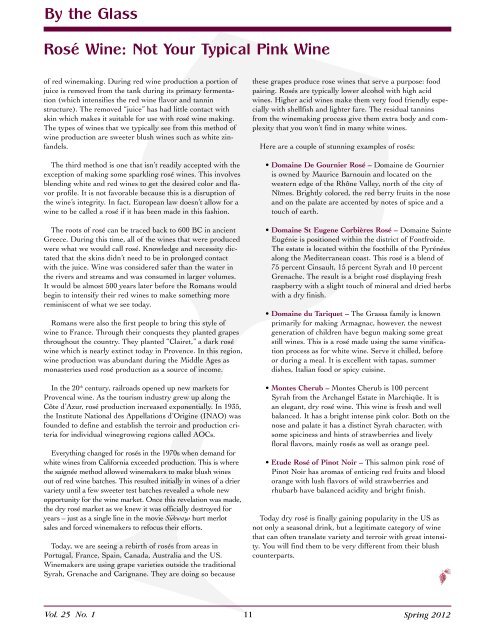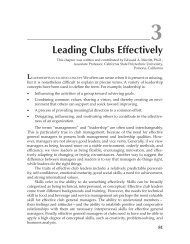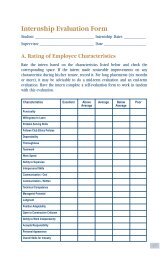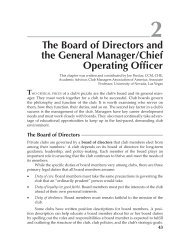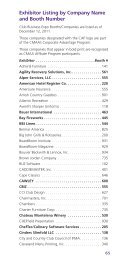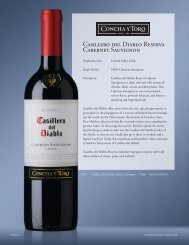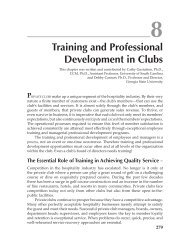Create successful ePaper yourself
Turn your PDF publications into a flip-book with our unique Google optimized e-Paper software.
By the GlassRosé Wine: Not Your Typical Pink Wineof red winemaking. During red wine production a portion ofjuice is removed from the tank during its primary fermentation(which intensifies the red wine flavor and tanninstructure). The removed “juice” has had little contact withskin which makes it suitable for use with rosé wine making.The types of wines that we typically see from this method ofwine production are sweeter blush wines such as white zinfandels.The third method is one that isn’t readily accepted with theexception of making some sparkling rosé wines. This involvesblending white and red wines to get the desired color and flavorprofile. It is not favorable because this is a disruption ofthe wine’s integrity. In fact, European law doesn’t allow for awine to be called a rosé if it has been made in this fashion.The roots of rosé can be traced back to 600 BC in ancientGreece. During this time, all of the wines that were producedwere what we would call rosé. Knowledge and necessity dictatedthat the skins didn’t need to be in prolonged contactwith the juice. Wine was considered safer than the water inthe rivers and streams and was consumed in larger volumes.It would be almost 500 years later before the Romans wouldbegin to intensify their red wines to make something morereminiscent of what we see today.Romans were also the first people to bring this style ofwine to France. Through their conquests they planted grapesthroughout the country. They planted “Clairet,” a dark roséwine which is nearly extinct today in Provence. In this region,wine production was abundant during the Middle Ages asmonasteries used rosé production as a source of income.In the 20 th century, railroads opened up new markets forProvencal wine. As the tourism industry grew up along theCôte d’Azur, rosé production increased exponentially. In 1935,the Institute National des Appellations d’Origine (INAO) wasfounded to define and establish the terroir and production criteriafor individual winegrowing regions called AOCs.Everything changed for rosés in the 1970s when demand forwhite wines from California exceeded production. This is wherethe saignée method allowed winemakers to make blush winesout of red wine batches. This resulted initially in wines of a driervariety until a few sweeter test batches revealed a whole newopportunity for the wine market. Once this revelation was made,the dry rosé market as we knew it was officially destroyed foryears – just as a single line in the movie Sideways hurt merlotsales and forced winemakers to refocus their efforts.Today, we are seeing a rebirth of rosés from areas inPortugal, France, Spain, Canada, Australia and the US.Winemakers are using grape varieties outside the traditionalSyrah, Grenache and Carignane. They are doing so becausethese grapes produce rose wines that serve a purpose: foodpairing. Rosés are typically lower alcohol with high acidwines. Higher acid wines make them very food friendly especiallywith shellfish and lighter fare. The residual tanninsfrom the winemaking process give them extra body and complexitythat you won’t find in many white wines.Here are a couple of stunning examples of rosés:• Domaine De Gournier Rosé – Domaine de Gournieris owned by Maurice Barnouin and located on thewestern edge of the Rhône Valley, north of the city ofNîmes. Brightly colored, the red berry fruits in the noseand on the palate are accented by notes of spice and atouch of earth.• Domaine St Eugene Corbières Rosé – Domaine SainteEugénie is positioned within the district of Fontfroide.The estate is located within the foothills of the Pyrénéesalong the Mediterranean coast. This rosé is a blend of75 percent Cinsault, 15 percent Syrah and 10 percentGrenache. The result is a bright rosé displaying freshraspberry with a slight touch of mineral and dried herbswith a dry finish.• Domaine du Tariquet – The Grassa family is knownprimarily for making Armagnac, however, the newestgeneration of children have begun making some greatstill wines. This is a rosé made using the same vinificationprocess as for white wine. Serve it chilled, beforeor during a meal. It is excellent with tapas, summerdishes, Italian food or spicy cuisine.• Montes Cherub – Montes Cherub is 100 percentSyrah from the Archangel Estate in Marchiqüe. It isan elegant, dry rosé wine. This wine is fresh and wellbalanced. It has a bright intense pink color. Both on thenose and palate it has a distinct Syrah character, withsome spiciness and hints of strawberries and livelyfloral flavors, mainly rosés as well as orange peel.• Etude Rosé of Pinot Noir – This salmon pink rosé ofPinot Noir has aromas of enticing red fruits and bloodorange with lush flavors of wild strawberries andrhubarb have balanced acidity and bright finish.Today dry rosé is finally gaining popularity in the US asnot only a seasonal drink, but a legitimate category of winethat can often translate variety and terroir with great intensity.You will find them to be very different from their blushcounterparts.Vol. 25 No. 1 11<strong>Spring</strong> 2012


